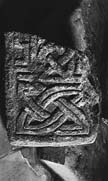Select a site alphabetically from the choices shown in the box below. Alternatively, browse sculptural examples using the Forward/Back buttons.
Chapters for this volume, along with copies of original in-text images, are available here.
Object type: Part of grave-cover
Measurements: L. 42 cm (16.5 in); W. 35 cm (13.75 in); D. 13 cm (5.1 in)
Stone type: [Barnack Rag type, Upper Lincolnshire Limestone, Inferior Oolite Group]
Plate numbers in printed volume: Ill. 360
Corpus volume reference: Vol 5 p. 262-263
(There may be more views or larger images available for this item. Click on the thumbnail image to view.)
A fragment from the foot end of a much larger grave-cover decorated with interlace in low relief.
A (broad): The original border of the monument was unmoulded and of rectangular section, though a chamfer has been cut down the arris of one long side during subsequent reuse. Within the border, the face was decorated with a broad central shaft which may have had cross-bars at several points. The lowest bar, across the foot of the shaft, survives on this fragment. The shaft and bar are themselves defined by a substantial fillet of rectangular section and are decorated with interlace in low relief. The only complete unit of the interlace to survive (within the cross-bar) forms a closed-circuit pattern of two interlinked oval loops ornamented with an incised medial line. The central shaft is decorated with the remains of a simple four-strand plait. In the spaces to either side of the shaft, and above the cross-bar, are two fillers which appear to have been part of a 'Greek key' pattern.
B (long) and C (end): Undecorated.
D (long): Damaged by later recutting.
E (end): Broken irregularly.
The grave-cover represented by this fragment was one of a large group of monuments of Barnack-like stone distributed throughout the Fenland (Chapter V and Table 5). The Tallington stone is somewhat exceptional within the group, however, in having more complex decoration. The great majority of examples (like Lincoln Cathedral 1, for example) have a simple unornamented cross surrounded by simple runs of plait (Ill. 230). Tallington, on the other hand, resembles a single example from Peterborough Cathedral and one member of the group discovered below the ramparts of Cambridge Castle (Ill. 486) in having a much more highly worked appearance (Fox 1920–1, no. XIV and no. 3 respectively). Like these two examples, Tallington has plaitwork and other motifs decorating the shaft and bar of the cross itself. Like the Peterborough example, especially, the cross at Tallington probably had several cross-bars. This group of three covers, then, stand out from the remainder of the large group of covers in Barnack stone in their concern for elaboration of the cross itself – a trait which is more reminiscent of late covers in the Celtic west (for example at Meifod or Llowes, Powys). The Cambridge Castle cover, however, was clearly part of the graveyard which also contained the much more simple examples and so there is unlikely to be a great difference in date between the two types. Both types of cover, the simple examples and the more complex, probably belong to the first half of the eleventh century and such a date would be appropriate for Tallington 1 also.



